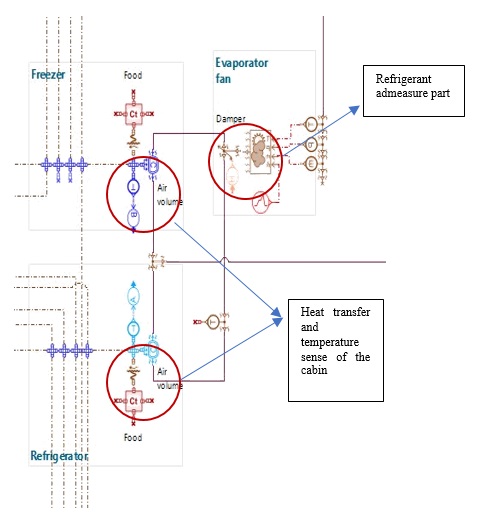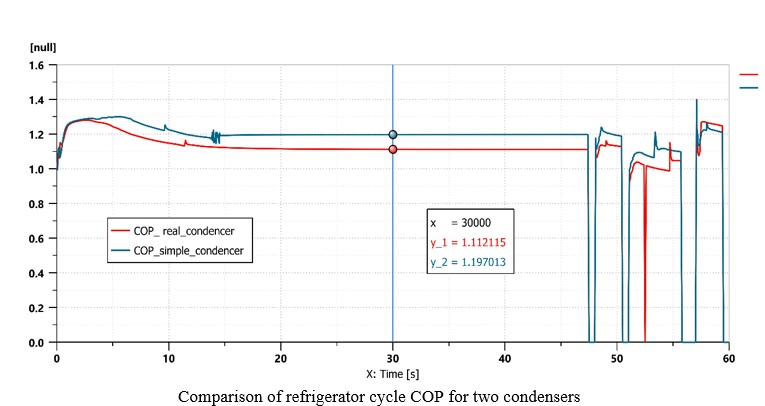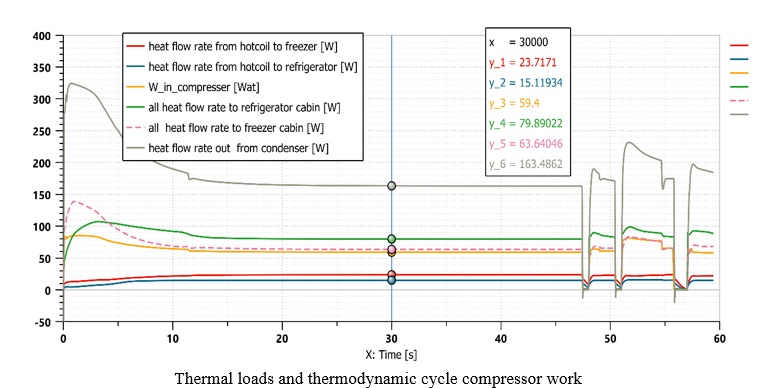Simulation of the refrigeration cycle of the refrigerator
Refrigerators are used to keep food fresh and healthy. But this is a primary goal of refrigerator design. In recent years, optimal energy consumption and better cooling of the refrigerator have been taken into consideration at the same time. In this way, the manufacturers plan to achieve this goal. Today, functional development and optimizations in the form of research and development projects in the context of software modeling and numerical calculations lead to increasing the efficiency of research and reducing the costs of the design and development process.
The main components of the refrigerator cooling system include: compressor, condenser, capillary tubes, pressure relief valve, evaporator and other components are modeled and work in connection with the interior and exterior of the refrigerator.

Physical phenomena in the model
The refrigerator works based on the principles of the thermodynamic cycle and the second law of thermodynamics. The thermodynamic cycle is necessarily a closed cycle in which a substance undergoes various processes and then returns to its original state. Cooling is usually done in a refrigerator through a vapor compression refrigeration system. In this system, cooling is done when “refrigerant” is converted into vapor by absorbing heat from the evaporator (this part is located in the space that is supposed to be cooled). The compressor is the most important component of any refrigerator without which the refrigerator does not work. This is a mechanical piece of equipment that transfers mechanical energy to the working fluid or refrigerant. The operation of the compressor is similar to the human heart; In this way, the heart sends blood throughout the body. In a similar way, the compressor adjusts and flows the refrigerant fluid in the entire refrigerator by increasing its pressure.
After leaving the refrigerant as a gas (superheat) from the compressor, the condenser changes the phase of the refrigerant by means of cooling. Now the refrigerant in liquid form (sub-cooled) leaves the condenser and enters the capillary tube (expansion valve). After reducing the pressure of the refrigerant fluid and turning it into a mixture of vapor and liquid at a low temperature, it enters the evaporator, and at this stage, the cooling process is performed by changing the phase of the refrigerant and absorbing heat from the refrigerator and freezer cabin. Then the low-pressure saturated steam enters the compressor to go through the cycle again.
Description of simulation model and design evaluation parameters by simulation
This system includes two mechanical (cooling) and electronic (control) parts, which are simulated in zero and one-dimensional form, and the function of each component is also modeled. The temperature and pressure of the refrigerant are monitored throughout the cycle, and if it goes out of its thermodynamic range, the simulation is stopped and after checking the error and fixing it, a correct software model is obtained. In this way, the desired performance parameters for the design and optimization of the refrigerator, such as: performance coefficient, energy consumption (including the required power of the compressor, defrost system and heater) and the cooling time of the refrigerator and freezer cabin are checked and for different working conditions. and environmental conditions have been studied.
Different temperature conditions outside/inside the refrigerator and working modes in the control system of the model are taken into account and can be checked and simulated according to the chosen program and flowchart. The important characteristic of this type of simulation is to separate from the complexities of 3D modeling, without applying extensive simplifications. In this way, the refrigeration cycle and the components of the cooling and control circuit in interaction with each other have been completely and accurately modeled and transiently (variable with time) using the thermomechanical relations governing the fluid in zero and one-dimensional simulation. Using the simulation model, the following can be done:
- Investigating the change of the heat transfer coefficient or thickness, etc. related to the refrigerator foam and its effect on the cooling action of the refrigerator
- Investigating the effect of changing the control system, compressor efficiency, changing the refrigerant, changing the size of the refrigerant, changing the condenser, changing the evaporator, changing the amount and time of defrost, etc. on the model and getting an idea for the desired real refrigerator.
- Calculation of the energy grade according to the existing standards in each mode of the device, suggesting a combination of changes in the refrigerator that can lead to a one-step increase in the energy grade.

The function of the simulation model
In the software model created of the refrigeration cycle, by changing or replacing each of the components, its effect on the performance parameters of the refrigerator can be studied, including the coefficient of performance (COP), efficiency and cooling speed. In this way, the specifications of the components of the refrigeration cycle of each of the product models, which are in line with the goals of the development project, are determined, and then the desired refrigerator enters the design and production stage. Due to adherence to the sustainable development program, such projects can play a key role in achieving an efficient and modern product. In fact, the main function of this model is to create an accurate calculation model of the refrigerator’s performance in order to establish ideal cooling conditions and at the same time consume energy from the start of operation. Using the obtained data, the energy grade of the desired refrigerator product can be calculated and prepared to enter the markets with strict energy laws.

Refrigerator product energy label for EU member countries market


